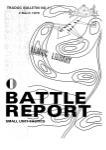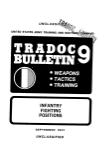/
Tags: warfare intelligence communities military equipment
Year: 1979
Text
D ЛЬ T "Ж" I Е
В I I L с
REPORT
COMBAT VEHICLE ENGAGEMENTS
REPORT DOCUMENTATION PAGE Form Approved 0MB No. 0704-0188
Public reporting burden for this collection of information is estimated to average 1 hour per response, including the time for reviewing instructions, searching existing data sources, gathering and maintaining the data needed, and completing and reviewing the collection of information. Send comments regarding this burden estimate or any other aspect of this collection of information, including suggestions for reducing this burden, to Washington Headquarters Services, Directorate for Information Operations and Reports, 1215 Jefferson Davis Highway, Suite 1204, Arlington, VA 22202-4302, and to the Office of Management and Budget, Paperwork Reduction Project (0704-0188), Washington, DC 20503.
1. AGENCY USE ONLY (Leave blank) 2. REPORT DATE 31 AUGUST 1979 3. REPORT TYPE ANO OATES COVERED FINAL
4. TITLE ANO SUBTITLE TRADOC BULLETIN 12. BATTLE REPORT: COMBAT VEHICLE ENGAGEMENTS 5. FUNDING NUMBERS
6. AUTHOR(S)
7. PERFORMING ORGANIZATION NAME(S) AND AOORESS(ES) HQ U.S. ARMY TRAINING AND DOCTRINE COMMAND ATTN: ATDOC-DDD FORT MONROE VIRGINIA 23651 8. PERFORMING ORGANIZATION REPORT NUMBER
9. SPONSORING / MONITORING AGENCY NAME(S) AND AOORESS(ES) 10. SPONSORING (MONITORING AGENCY REPORT NUMBER
11. SUPPLEMENTARY NOTES See TRADOC Bulletin 11 dated 2 March 1979
12a. DISTRIBUTION / AVAILABILITY STATEMENT APPROVED FOR PUBLIC RELEASE; DISTRIBUTION IS UNLIMITED. 12b. DISTRIBUTION CODE
13. ABSTRACT (Maximum 200 words) Recent technological advances have led to armor developments which substantially improve armored vehicle protection against both kinetic and chemical energy projectiles. Such armor is normally found on the front of modern tanks. So engage enemy tanks from flanks and rear. Locate battle positions along the flanks of enemy avenues of approach to allow flank and rear shots. Flank positions also place the enemy at a disadvantage because he must divide his attention in three directions--to the front and sides. Since engagement ranges are usually shorter from flank positions, there is a better chance of hitting the target. Also, more enemy targets will normally be in range. Discussion includes the tube-launched, optically tracked, wire-guided antitank missile (TOW); Dragons; Tanks; Mines and obstacles.
14. SUBJECT TERMS 15. NUMBER OF PAGES 13
16. PRICE CODE
17. SECURITY CLASSIFICATION OF REPORT UNCLASSIFIED 18. SECURITY CLASSIFICATION OF THIS PAGE UNCLASSIFIED 19. SECURITY CLASSIFICATION OF ABSTRACT UNCLASSIFIED 20. LIMITATION OF ABSTRACT UNLIMITED
NSN 7540-01-280-5500
Standard Form 298 (Rev. 2-89)
Prescribed by ANS! Std. Z39-18 298-102
USAPPCV1.O0
UNITED STATES ARMY
TRAINING AND DOCTRINE COMMAND
BULLETIN NO 12
RATTI F RFPORT’
COMBAT VEHICLE ENGAGEMENTS
Battle reports are used to disseminate lessons learned about how to fight
on the modern battlefield. Data derived from observations, simulations,
tests, and/or other evaluations are in the form of TRADOC bulletins
entitled “Battle Reports.*’ These reports convey important developments
of immediate interest to TRADOC agencies and to field commanders. They
provide interim guidance until their content can be integrated into
appropriate How-To-Fight, How-To-Support, or other doctrinal publications.
TRADOC centers, schools, agencies, and field commanders are
encouraged to submit material for inclusion in future battle reports to HQ
TRADOC, ATTN: ATDOC-DDD, Fort Monroe, VA 23651.
Contents
Page
INTRODUCTION .................................... 2
TOWs ............................................ 2
DRAGONS ......................................... 5
TANKS............................................ 6
MINES AND OBSTACLES.............................. 9
1
TRADOC BULLETIN 12
BATTLE REPORT
Introduction
Recent technological advances have Jed to armor developments which
substantially improve armored vehicle protection against both kinetic and
chemical energy projectiles. Such armor is normally found on the front of
modern tanks. So engage enemy tanks from flanks and rear.
Locate battle positions along the flanks of enemy avenues of approach to
allow flank and rear shots. Flank positions also place the enemy at a
disadvantage because he must divide his attention in three directions-—to
the front and sides.
Since engagement ranges are usually shorter from flank positions, there
is a better chance of hitting the target. Also, more enemy targets will
normally be in range.
TOWs
(Tube-launched, optically tracked, wire-guided antitank missile)
Position TOWs to kill enemy armored vehicles from the flanks. Avoid
shooting TOWs at the front of enemy tanks. Remember, the gun on an
attacking tank is usually pointed in the direction the tank is moving—to the
front.
2
BATTLE REPORT
TRADOC BULLETIN 12
If you shoot from the flanks, the enemy tank will have trouble seeing you.
If the enemy can’t see you, he can’t shoot you so hit him in his blind area.
BUND AREA
Use hide positions for TOWs when not firing. This means you must use
observers to find targets and call TOW vehicles forward to firing positions.
Prepare TOW firing positions so that TOW vehicles can move into them
rapidly. Make sure these positions have cover, concealment, and covered
routes of withdrawal.
Select alternate positions so they can be used if primary positions are
smoked.
3
TRADOC BULLETIN 12
BATTLE REPORT
Л~...............
• ENGAGE ENEMY EARLY WHEN HE IS STILL IN
• POSITION TOWs SO FIRES OF ONE OVERLAP FIRES
OF OTHERS. THIS PROVIDES FOR EXTRA CREW
PROTECTION AND INCREASES THE CHANCE OF
KILLING TANKS AND BMPs.
4
BATTLE REPORT
TRADOC BULLETIN 12
Dragons
Put Dragons in areas that have good cover and concealment. Since
Dragons are ground mounted, crew protection depends on a well-prepared
position.
Position Dragons to kill enemy tanks from flanks and rear. First, kill
tanks and BMPs that present the greatest threat, then the others.
Position Dragons so that fires of one overlap fires of others. Position
Dragons to kill tanks and BMPs attacking other Dragon positions.
Select alternate positions that can be reached by covered routes. Move to
these alternate positions when primary positions are smoked or discovered.
Select covered withdrawal routes that allow a quick return to fighting
vehicles.
5
TRADOC BULLETIN 12
BATTLE REPORT
Tanks
Use the armor protection and mobility of tanks to move quickly between
hastily prepared positions in front of and on flanks of the enemy.
Position tanks across the avenue of approach as well as the flanks. As
the enemy approaches the battle position, tanks across the avenue of
approach engage at maximum range. When the enemy moves within range
of the tanks and antitank guided missiles (ATGM) located on flanks, the
weapons engage.
6
BATTLE REPORT
TRADOC BULLETIN 12
Use crossfire when you’re astride enemy avenues of approach.
Use depth fire when you’re positioned on the flanks.
7
TRADOC BULLETIN 12
BATTLE REPORT
Position tanks on either flank of an avenue of approach so that their fires
overlap. Overlapping fires increase the chances of killing all enemy tanks.
Position tanks so they can move rapidly between positions. Move tanks
along covered routes to positions where they can counterattack the enemy
with fire.
Select alternate positions that can be reached by covered routes. Move to
these alternate positions when primary positions are smoked.
—
USE COVERED POSITIONS TO COUNTERATTACK WITH FIRE
SCOUT ALTERNATE POSITIONS AND
COVERED ROUTES BEFOREHAND
В
BATTLE REPORT
TRADOC BULLETIN 12
Mines and Obstacles
When tanks and ATGMs cannot be positioned for flank shots because
of terrain, use mines and obstacles to make the enemy change direction
so his flanks are exposed.
r SEQUENCE 1 OF 2
ENEMY APPROACHING — FLANKS UNEXPOSED
• TERRAIN DOES NOT ALLOW FLANK SHOTS
• DEFENDER CANNOT DESTROY MASSED ENEMY
WITH FRONTAL FIRE
9
BATTLE REPORT
FRADOC BULLETIN 12
SEQUENCE 2 OF 2
ENEMY DIRECTION CHANGED — MINES HAVE EXPOSED FLANK
• MASS FIRES ON ENEMY MINE ROLLERS AND PLOWS
TRYING TO MAKE LANES THROUGH MINEFIELDS
• PLACE MINES AT RANGES WHERE BOTH TANKS
AND TOWs CAN KILL ENEMY ARMORED VEHICLES
10
BATTLE REPORT
TRADOC BULLETIN 12
Ordering TRADOC Bulletins
A series of TRADOC Bulletins is being published by HQ TRADOC to
provide commanders with timely technical information on weapons,
tactics, and training techniques. The bulletins are not intended to supplant
doctrinal publications, but to supplement how-to-fight material with data
derived from tests, intelligence, or other sources which probe “why?”
TRADOC Bulletins are developed by HQ TRADOC, using the most com-
prehensive and current military and civilian data available. Army Training
and Evaluation Programs (ARTEP), Field Manuals (FM), and Training
Circulars (TC) continue to be the primary training references. TRADOC
Bulletins supplement them with an explanation of why we are training in a
given manner. TRADOC Bulletins should enable commanders to better
stimulate and motivate subordinates to understand why we train the way
we do.
TRADOC Bulletins are cataloged in DA Pamphlet 310-3 (Index of
Doctrinal, Training and Organizational Publications). The series is
numbered consecutively, and each TRADOC Bulletin is announced at the
time of printing in the information bulletin distributed to all pinpoint
account holders by the US Army AG Publications Center.
Additional copies can be requisitioned from the US Army AG
Publications Center, Baltimore, MD 21220.
DA Pamphlet 310-10 explains the pinpoint distribution system and how to
establish or update an existing account at the US Army AG Publications
Center.
11
TRADOC BULLETIN 12
31 AUGUST 1979
General, UnitedStatesArmy
Commanding
DISTRIBUTION:
Active Army, USAR, and ARNG.To be distributed in accordance with DA Form 12-11 B, Require-
ments for TRADOC Training Bulletins (Qty rqr block no 432).
Additional copies can be requisitioned from the US Army Adjutant General Publications Center,
2800 Eastern Boulevard, Baltimore, MD 21220.
BATTLE REPORT
TRADOC BULLETIN 12
FEEDBACK - YOUR TURN
TRADOC Bulletins are designed to present timely information on weapons, tactics, and training
to units in the field. Bulletins focus on the "why" or rationale for our doctrine. Your response to
the questionnaire will help us stay on target.
1. Rank В ra n c h Ту p e U n it--
Component(Act, NG, Res)
2. Are you located at:
Company level Battalion level Brigade level Other (specify)
3. Where did you see this bulletin?
Company dayroom Orderly room — Library Other (specify)
4. Did this bulletin (check any or all):
------------------ Give you info you didn't know before?
------------------ Help in training?
------------------ Provide you with info you received before?
Convince you that you should do something differently?
5. Which leaders/soldiers in your units do you think will make best use of this bulletin?
E3/E4 PLT LDR BN STAFF
E5/E6 1ST SGT BNCDR
PLT SGT CO CDR OTHER
6. How will this bulletin be used in your unit?
7. Which of these Bulletins have you read?
#1 (C) Range and Lethality of US and Soviet Antiarmor Weapons (U)
#1 (U) Range and Lethality of US and Soviet Antiarmor Weapons
#2 (C) Soviet ATGMs: Capabilities and Countermeasures (U)
#2 (U) Soviet ATGMs: Capabilities and Countermeasures
#3 (C) The Soviet RPG-7 Antitank Grenade Launcher (U)
#3 (U) The Soviet RPG-7 Antitank Grenade Launcher
_____ #4 (C) Soviet ZSU 23-4: Capabilities and Countermeasures (U)
#5 (U) Training with LAW
#6 (U) Countersurveillance and Camouflage
#7 (U) The BMP: Capabilities and Limitations
_____ #9 (U) Infantry Fighting Positions
#10 (U) Soviet Main Battle Tank: Capabilities and Limitations
----- #11 (U) Battle Report: Small Unit Tactics
8. What other types of Bulletins would help you?
9. Other comments:



